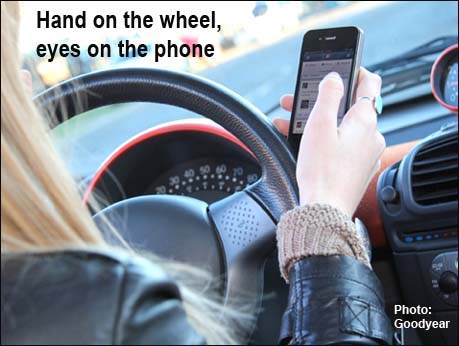
This holiday season, we bring you the results of a special survey that warns of the dangers -- and the largescale prevalance worldwide -- of driving while speaking or texting on a phone. Have a happy ( and safe) holiday!Brussels, Belgium, December 22 2012: A smart phone might not be the safest present to give young drivers this Christmas and New Year holiday season, advises the world’s largest tire company, Goodyear – basing its suggestion on a survey it commissioned probing the behaviour of 6400 young drivers aged 25 and below in 16 markets.
The research by Goodyear reveals that the majority of young drivers are likely to put themselves in danger by using their new devices at the wheel. Youngsters continue to phone, text and surf the web even when they are at the wheel: 45% admit to speaking on the phone while driving and 68% have seen their friends phoning while at the wheel.
“Today’s young drivers have too many distractions at their finger-tips and the Christmas smartphone boom is going to continuously increase the number of mobile devices used while driving. We designed our third annual Road Safety survey to probe precisely how these gadgets are used by young drivers,” explained Lie Junius, Goodyea’s Director Public Affairs, EMEA.
The survey revealed a host of distractions competing for the attention of today‟s young drivers as they climb into their cars. Despite the fact that it is illegal in most countries, 44% speak on the phone without using a handset or hands-free while driving. Considered as more dangerous than phoning on the road, texting was also highlighted: 41% of newly qualified drivers admit to having sent texts, emails or using messenger services while driving.
Explains Dr. Alex W Stedmon, a Reader in Human Factors at Sheffield Hallam University and owner of a specialized transport simulation company: “Contrary to popular belief, the brain is not capable of multi-tasking. What happens is that the brain carries out tasks sequentially, switching very quickly from one to another so that we may often perceive that we’re doing more than one thing at once. The prefrontal cortex of the brain, associated with attention and concentration, can all too easily become overwhelmed if drivers attempt to undertake numerous actions at once, seriously compromising their own safety and that of other road users. The distraction caused by carrying out multiple tasks while driving is known by experts as ‘inattention blindness’. Typically what happens is that a driver’s cognitive abilities are compromised by the amount of processing required to conduct multiple tasks. This can occur to such an extent that they then fail to observe events around them or react in normal time. The danger with this is that we are often totally unaware of the impact of attempting multiple tasks until we have a clear lapse of concentration. When talking on a mobile phone a driver may look at objects but simply not see them. The underlying information processing is restricted as the task of phoning draws too much mental effort without the driver realising.”
“Those that multi-task at the wheel may acquire a false confidence and believe that they can complete a series of tasks while also driving. To an extent this may be possible but problems occur when something unexpected happens and they need to react in a split-second by quickly braking or changing or changing lane. In these situations their judgement is impaired,” warns Stedmon